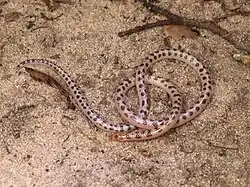Xenocalamus mechowii
| Xenocalamus mechowii | |
|---|---|

| |
| Scientific classification | |
| Kingdom: | Animalia |
| Phylum: | Chordata |
| Class: | Reptilia |
| Order: | Squamata |
| Suborder: | Serpentes |
| Family: | Atractaspididae |
| Genus: | Xenocalamus |
| Species: | X. mechowii
|
| Binomial name | |
| Xenocalamus mechowii W. Peters, 1881
| |
Xenocalamus mechowii, or the elongate quill-snouted snake, is a species of mildly venomous rear-fanged snake in the subfamily Aparallactinae of the family Atractaspididae.[1] The species is endemic to Africa.[2] There are two recognized subspecies.[2]
Etymology
The specific name or epithet, mechowii, is in honor of Friedrich Wilhelm Alexander von Mechow, a Silesian-German explorer of Africa.[3]
Geographic range
Xenocalamus mechowii is found in Angola, Botswana, Republic of the Congo, Democratic Republic of the Congo, Namibia, Zambia, and Zimbabwe.[2]
Habitat
The preferred habitat of Xenocalamus mechowii is Kalahari sand.[4]
Description
Dorsally, Xenocalamus mechowii is yellowish with brown spots, some spots arranged in alternating confluent pairs, others forming crossbands. The upper lip, sides of the body, and venter are unspotted.[5]
A subadult 22.5 cm (8+3⁄4 in) in total length has a tail 3.5 cm (1+3⁄8 in) long.[5]
The species exhibits sexual dimorphism. Adult males may attain a snout-to-vent length (SVL) of 58 cm (23 in). Females are larger, and may attain 80 cm (31 in) SVL.[4]
The dorsal scales are smooth, without apical pits, arranged in 17 rows. The ventrals number 229–239. The anal plate is divided, and the subcaudals which number 31–36 are also divided.[5]
The head scalation is the same as Xenocalamus bicolor, except there are no supraoculars and two postoculars.[5]
The snout is very depressed and very prominent.[4]
Diet
Xenocalamus mechowii preys on amphisbaenians, which it finds by burrowing.[4]
Reproduction
Xenocalamus mechowii is oviparous. An adult female may lay a clutch of as many as four eggs.[4]
Subspecies
Two subspecies of Xenocalamus mechowii are recognized as being valid, including the nominate race.[2]
- Xenocalamus mechowii inornatus de Witte & Laurent, 1947
- Xenocalamus mechowii mechowii W. Peters, 1881
Intergrades of these two subspecies can be found in North-Western Province, Zambia.[6]
References
- ^ "Xenocalamus ". Integrated Taxonomic Information System. Retrieved 8 April 2019.
- ^ a b c d Xenocalamus mechowii at the Reptarium.cz Reptile Database. Accessed 12 May 2009.
- ^ Beolens, Bo; Watkins, Michael; Grayson, Michael (2011). The Eponym Dictionary of Reptiles. Baltimore: Johns Hopkins University Press. xiii + 296 pp. ISBN 978-1-4214-0135-5. (Xenocalamus mechowi, p. 174).
- ^ a b c d e Branch, Bill (2004). Field Guide to Snakes and other Reptiles of Southern Africa. Third Revised edition, Second impression. Sanibel Island, Florida: Ralph Curtis Books. 399 pp. ISBN 0-88359-042-5. (Xenocalamus mechowii, p. 69).
- ^ a b c d Boulenger GA (1896). Catalogue of the Snakes in the British Museum (Natural History). Volume III., Containing the Colubridæ (Opisthoglyphæ and Proteroglyphæ), Amblycephalidæ, and Viperidæ. London: Trustees of the British Museum (Natural History). (Taylor and Francis, printers). xiv + 727 pp. + Plates I–XXV. ("Xenocalamus mechovii [sic]", p. 248).
- ^ Broadley DG (1971). "A revision of the African snake genera Amblyodipsas and Xenocalamus ". Occasional papers of the National Museums of Rhodesia, Series B, Natural sciences 4 (33): 629–697.
Further reading
- Peters WCH (1881). "Zwei neue von Herrn Major von Mechow während seiner letzten Expedition nach West-Afrika entdeckte Schlangen und eine Übersicht der von ihn mitgebrachten herpetologischen Sammlung ". Sitzunsberichte der Gesellschaft naturforschender Freunde zu Berlin 1881 (9): 147–150. (Xenocalamus mechowii, new species, p. 147). (in German).
- de Witte GF, Laurent RF (1947). "Revision d'un groupe de Colubridae africains: genres Calamelaps, Miodon, Aparallactus, et formes affines ". Mémoires du Muséum Royal d'Histoire Naturelle de Belgique (sér. 2) 29: 1–134. (Xenocalamus mechowii inornatus, new subspecies, p. 51). (in French).
External links